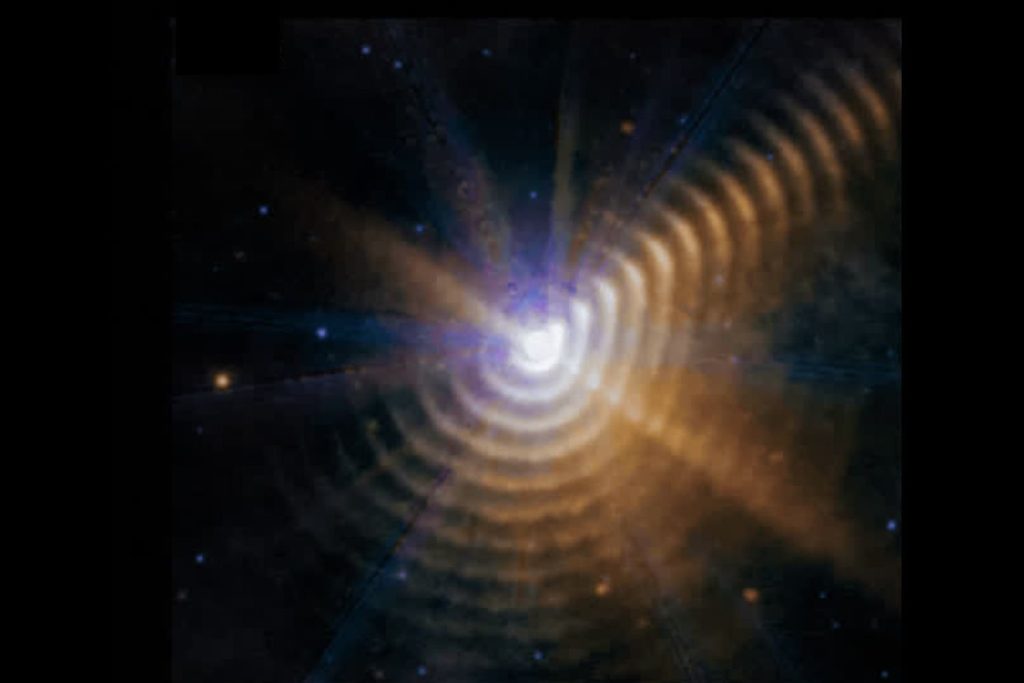Beautifully Detailed Webb Image Shows ‘Shelled’ Star on the Verge of Death – Gizmodo

The Webb Space Telescope just captured a transfixing image of Wolf-Rayet 140, a binary star system in our galaxy surrounded by concentric rings of dust.The stars’ dust rings give the system the appearance of a tree’s cross-section, but on a stellar scale. The system, located roughly 5,000 light-years from Earth, was captured in a Webb image that confirmed the rings’ existence and offered clues about how elements like carbon may be dispersed across the universe.The team of astronomers that investigated the Webb images published its analysis in The Astrophysical Journal Letters this month, and presented its findings in the ongoing 245th meeting of the American Astronomical Society in National Harbor, Maryland.“The telescope not only confirmed that these dust shells are real, its data also showed that the dust shells are moving outward at consistent velocities, revealing visible changes over incredibly short periods of time,” explained Emma Lieb, a researcher at the University of Denver and the study’s lead author, in a NASA release.Wolf-Rayet stars are supernovae in the making. The stars are generally larger than the Sun, but are rapidly losing mass as they reach the ends of their lives. When the stars do eventually die, they energetically expel their material out into space in a brilliant supernova. Only one of the stars in WR 140 is a Wolf-Rayet star, roughly 10 times more massive than the Sun.Webb has imaged Wolf-Rayet stars before; in 2023, the space observatory captured a brilliant view of WR 124, a star about 30 times the mass of the Sun that sits about 15,000 light-years from Earth. WR 124’s streams of gas and dust are issuing away from the system’s central star at more than 93,200 miles per hour (150,000 kilometers per hour).The star system has issued more than 17 dust shells out into space over the past 130 years. The system’s oldest shells have dissipated to the extent that they are no longer detectable.WR 140’s shells are moving even faster than gas and dust around WR 124; the shells are expanding at a rate of more than 1,600 miles per second (2,600 km/s).The animation above shows how the dust shells generate and emanate from interactions between the two stars at the heart of the system. The stars’ winds collide and material compresses into a carbon-rich dust, which is flung out into space.The dust creation happens once, over the course of several months, in every eight-year orbit the stars make. So the tree ring metaphor goes further—each ring you see in the below image marks one orbital period for the system.The Webb Space Telescope took the two mid-infrared images above in July 2022 (left) and September 2023 (center). As you can see from the blown-up inset image (right), the dust shells have expanded outwards considerably in just 14 months.“Mid-infrared observations are absolutely crucial for this analysis, since the dust in this system is fairly cool. Near-infrared and visible light would only show the shells that are closest to the star,” said study co-author Ryan Lau, an astronomer at NSF’s NOIRLab, in the same release. “With these incredible new details, the telescope is also allowing us to study exactly when the stars are forming dust — almost to the day.”It’s not clear exactly when—or how—the Wolf-Rayet star in the system will die. The star may go supernova, or could collapse into a black hole. If the star turns into a black hole, the dust shells surrounding the object would remain intact—whereas a supernova would likely obliterate the material as the star explodes.No matter the timeline for the star’s death, the Webb Space Telescope is clearly a handy tool for seeing how this distributor of carbon-rich material delivers its product across space.
Binary starscarbonDuststarswebb space telescope
Get the best tech, science, and culture news in your inbox daily.
News from the future, delivered to your present.
Please select your desired newsletters and submit your email to upgrade your inbox.
Astronomers have never detected mid-infrared flares from our galaxy’s supermassive black hole—until now.
The circumgalactic medium, a vast gaseous halo surrounding galaxies, could be crucial to the evolution of star-forming galaxies like our own.
The cutting-edge observatory is charged with seeing some of the earliest visible light, and the recent image achieves a new milestone in stellar astronomy.
New images from Webb Space Telescope reveal massive, ancient spiral galaxies.
Perplexing data in the early 2000s raised questions about how planetary formation began in the universe, and new data from Webb provides some answers.
At 3.8 million miles from the Sun’s surface, Parker Solar Probe will be the closest a human-made object’s ever been to our host star.
Best of CES 2025 Awards ➜We may earn a commission when you buy through links on our sites.
©2025 GIZMODO USA LLC. All rights reserved.Mode
Follow us
Mode
Follow us






